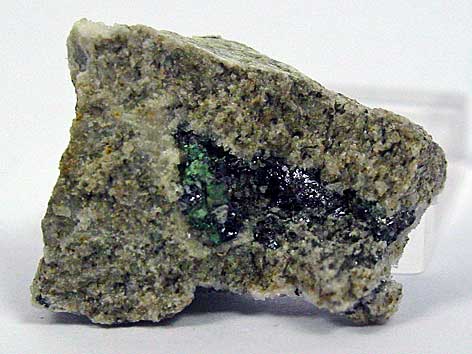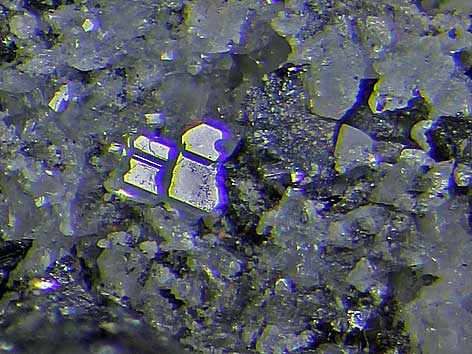
farblose Leadhillit xx neben Quarz u. a. auf Galenit
Grube Silberkaule, Heckhaus, Bergisches Land, Nordrhein-Westfalen, BRD
Stufe: 20 x 14 mm

Leadhillit xx
Detail der links abgebildeten Stufe
Bildbreite: 2 mm
|
Leadhillit |
|
|
Formel: |
Pb4(SO4)(CO3)2(OH)2 (5.BF.40; Leadhillit-Gruppe). |
|
Ausbildung: |
monoklines Kristallsystem; Polymorph von Macphersonit und Susannit; farblos, weiß, graugelb, blassblau; überwiegend dünn- bis dicktafelige pseudohexagonale Kristalle mit hexagonalem Umriss, auch Prismen oder rhomboedrische, pyramidale oder granulare Formen. |
|
Entdeckung: |
1817 - von Bournon (= Plomb carbonate rhomboidal); 1820 - Brooke (= Sulphatotricarbonate of lead); Leonhard (= Schwefelkohlensaures Blei); Haidinger (= Axotomer Bleibaryt); Weiss (= Ternärbleispat); Glocker (= Psysmithit); Laspeyres (= Maxit); 1832 - Francois Sulpice Beudant, dieser benannte das Mineral nach der Typlokalität Leadhills in Schottland. |
|
Typlokalität: |
UK, Schottland, South Lanarkshire, Leadhills, Susanna Vein (Susanna Mine). |
|
Seltenheit: |
wenig verbreitet (Mineralienatlas: 291 / Mindat: 317 Lokalitäten; 2025). |
|
farblose Leadhillit xx neben Quarz u. a. auf Galenit Grube Silberkaule, Heckhaus, Bergisches Land, Nordrhein-Westfalen, BRD Stufe: 20 x 14 mm
|
 Leadhillit xx Detail der links abgebildeten Stufe Bildbreite: 2 mm
|
Quellen: Sammlung und Fotos Matthias Kahl; allg. Mineralbeschreibung nach Mineralienatlas.de, Mindat.org, Handbook of Mineralogy, DeWikipedia und/oder Lapis-Mineralienmagazin
© copyright Matthias Kahl